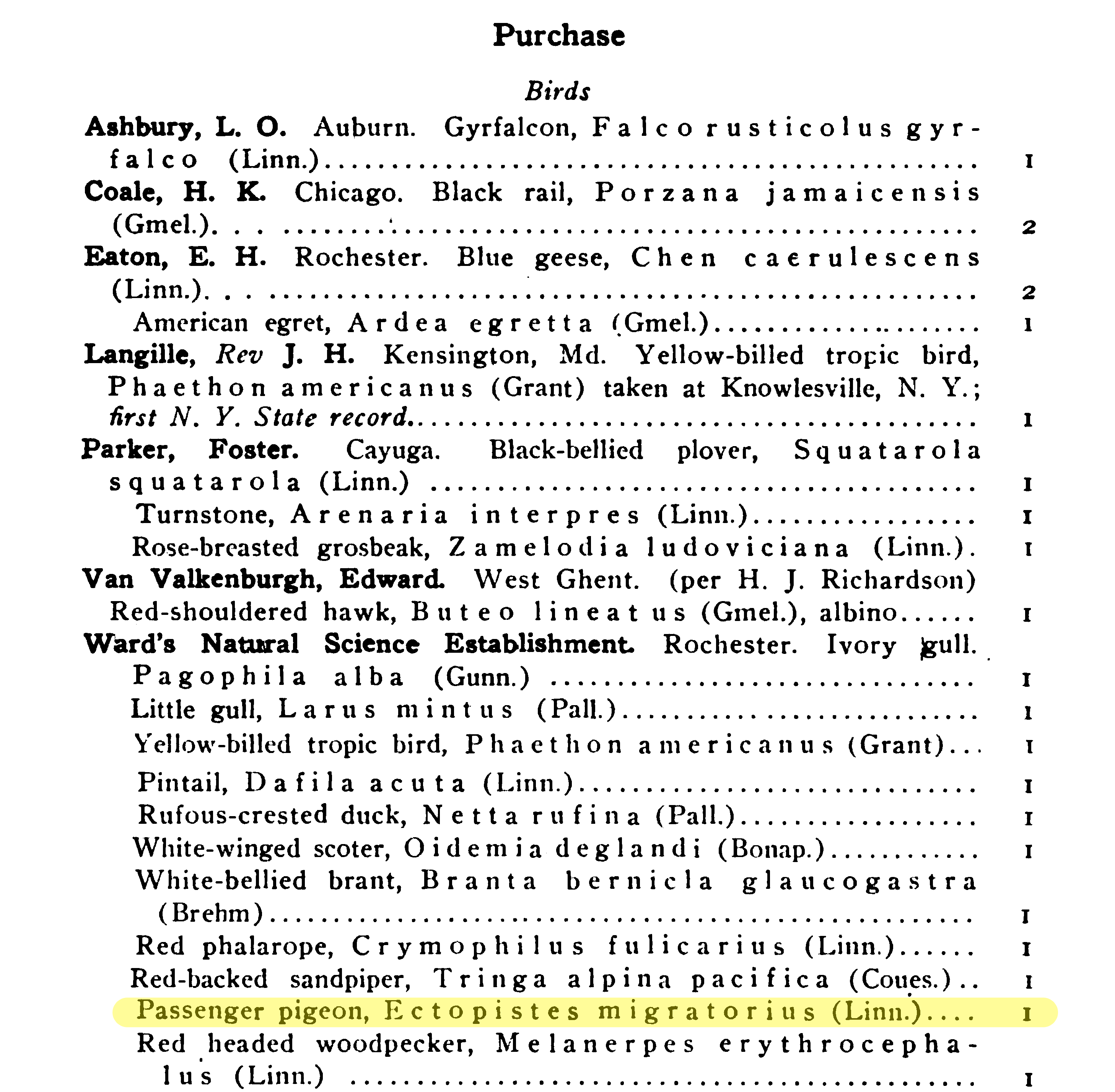
In 1908 the New York State Museum purchased a passenger pigeon from Ward’s Natural Science Establishment in Rochester, NY (NYSM 1908:134). The late date of this acquisition is interesting. By this time, the species was considered extinct in the wild. Martha, the last known passenger pigeon, of course, died in captivity in 1914. The latest confirmed killing of a passenger pigeon that Schorger (1955) was aware of occurred in 1900 in Ohio. Greenberg (2014) has since identified two more recent records: a passenger pigeon killed in Illinois in 1901 that survives as a taxidermic mount at Millikin University, and a pigeon killed in Indiana in 1902. That specimen has not survived.
There were, however, unconfirmed sightings of passenger pigeons in the wild. Most, if not all of these, were likely misidentifications of the smaller mourning dove. Schorger has pointed out how even experienced observers could make such a mistake.
The latest confirmed kill of a passenger pigeon in New York was in 1899. Yet a passenger pigeon nest was reported from Monroe County, New York, in 1904 and in 1907 Edmund Niles Huyck saw a live pigeon in Albany County and naturalist John Burroughs recorded sightings of flocks of pigeons in the Hudson Valley (Greenberg 2014; Steadman 1996).
Is it possible that a collector working for Ward’s killed a wild passenger pigeon that was then sold to the Museum? Perhaps, although Ward’s Natural Science was a major supplier of passenger pigeons and all sorts of animals to museums and other institutions. It seems more likely that the State Museum bought a specimen prepared by Ward’s years earlier that had been sitting unsold in a warehouse. In fact, another source, Frank H. Ward himself, tells us that the company obtained their passenger pigeons the same way many other people did: by buying them in public markets in the 1880s. At the time of the death of Martha, the last passenger pigeon, in 1914, Ward’s still had eight skeletons in stock (Pitelka and Bryant 1942).
The New York State Museum has several passenger pigeons in their collections — ten mounted skins according to David Steadman, the former curator of birds there. An earlier report listed five mounted specimens and two study skins at the museum, of which only one, a mounted specimen collected in 1895 from Orleans County, New York, had reliable provenience (Stoner 1940).
The pigeon from Ward’s, whether a stuffed taxidermic mount or a mounted skeleton, is presumably still at the NYSM. Their products would have had a label with the name of the company, but this would not be considered provenience data, as it would not have the date and location the bird was actually obtained. A search of the museum’s archives and an examination of the bird itself might produce more information. The University of Rochester curates the archives of the Ward’s company (link), but a fire in 1930 destroyed many of the earlier records, so it may not possible to ever determine if this bird was truly one of the last wild passenger pigeons.
References:
Greenberg, Joel
2014 A Feathered River Across the Sky: The Passenger Pigeon’s Flight to Extinction. Bloomsbury USA.
New York State Museum
1908 Fourth Report of the Director of the Science Division including the 61st Report of the State Museum, the 27th Report of the State Geologist, and the Report of the State Paleontologist for 1907. New York State Museum Bulletin 121. Albany.
Pitelka, Frank A., and Monroe D. Bryant
1942 Available skeletons of the passenger pigeon. The Condor 44:74-75.
Schorger, A.W.
1955 The Passenger Pigeon: Its Natural History and Extinction.
Steadman, David W.
1996 …And live on pigeon pie: the passenger pigeon finally expired at the Victorian dining table. New York State Conservationist. April, pp. 21-23.
Stoner, Dayton
1940 Unreported New York State specimens of passenger pigeon. The Auk 57:415-416.
1 comment